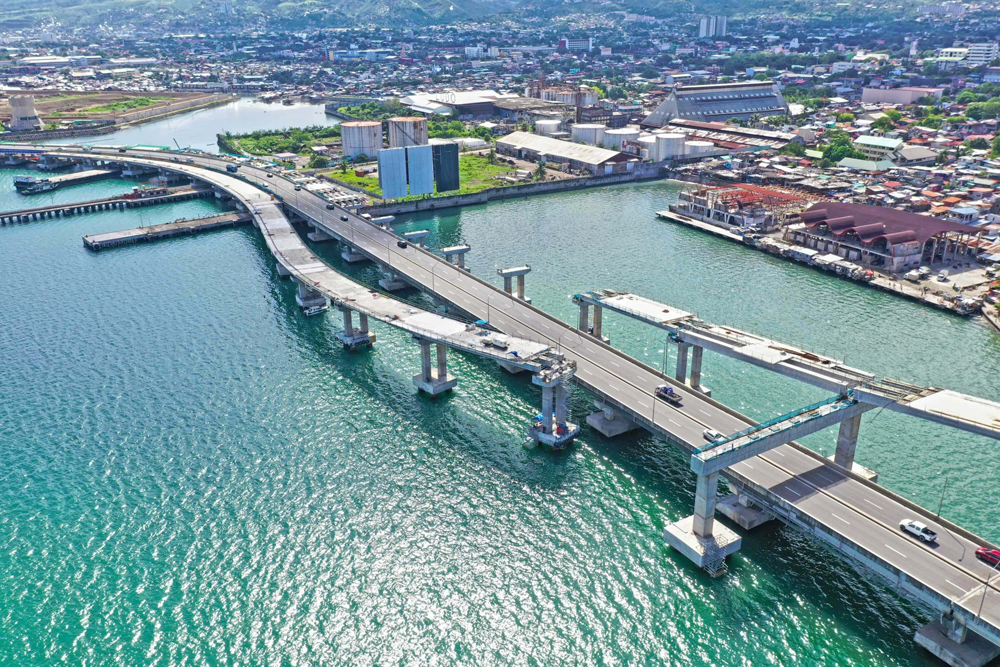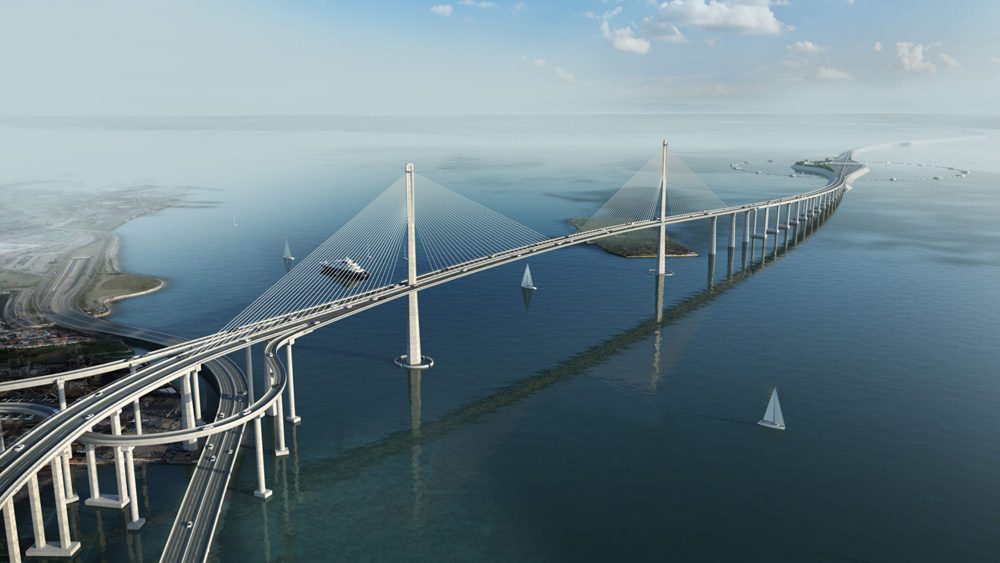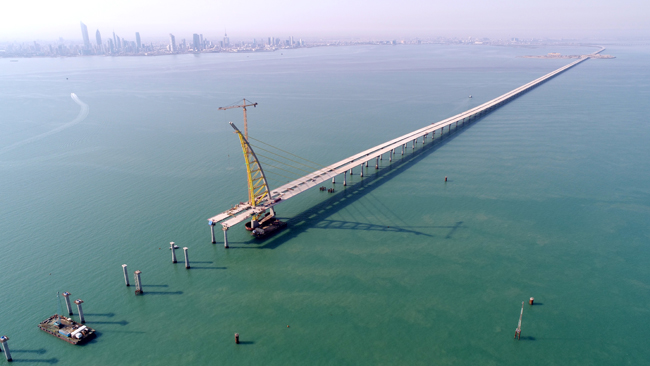The Cebu–Cordova Link Expressway (CCLEx), also known as the Cebu–Cordova Bridge, is a combined toll bridge and causeway that stretches 8.5km across the Mactan Channel (also known as the Opon Channel). It will link Cebu City, with a population of around 1 million and on Cebu Island – nearly 4,700km² in size - with the town of Cordova on the much smaller island of Mactan – 65km² in area.
The greater Cebu City region, however, has as population closer to 3 million. As such, the goal is to relieve traffic congestion on two existing bridges across the Mactan Channel and help improve the economic fortunes of the surrounding Visayas Region.
The north-west coast of Mactan island is much closer to Cebu Island than its southern region, which is where the new bridge and causeway is being constructed. To the north of the new bridge where the Mactan Channel narrows, lie the much shorter Mactan–Mandaue Bridge and the Marcelo Fernan Bridge (see box).
The new Cebu–Cordova Link Expressway is a four-lane, 27m-wide cable-stayed two-pylon bridge that allows a 51m navigational clearance. It has a design vehicle speed of 80-90kph and is expected to handle at least 50,000 vehicles daily, according to the website of CCLEx. It will also cut 40 minutes off the drive to Mactan Cebu International Airport on Mactan Island – the second busiest international airport in the Philippines.

At 8.5km long, the Cebu–Cordova Link Expressway will be the longest and tallest bridge in the Philippines. It will surpass the San Juanico Bridge Expressway (2.1km) that opened in 1973 and the 5km Candaba Viaduct that opened in 1977 and which is part of the North Luzon Expressway - an 84km, four-to-eight lane expressway connecting Metro Manila to the provinces of the Central Luzon region.
The complete CCLEx structure will consist of the main bridge, plus on and off ramps connecting the main bridge to the Cebu South Coastal Road as well as a viaduct that levels down to the causeway in Cordova’s Pilipog Barangay.
A Barangay is the smallest political unit in the Philippines, essentially a tiny municipality.
The expressway was scheduled to open this year but this has been pushed back to next year. Just over 70% of construction has been completed, according to CCLEx.
In April, the public witnessed for the first time the illumination of the 40m-high Christian crosses sitting atop the bridge’s two 145m-high pylons.
The crosses, which on the night were blessed by priests, are there to celebrate the 500th anniversary of Christianity coming to the Philippines, notes the CCLEx website. “These crosses will illuminate the skyline of Metro Cebu - beacons of hope and progress, symbols of achievement and everything Cebuanos are proud of,” said Manuel Pangilinan, chairman of Metro Pacific Tollways on the night of illumination.
Milestone
Trevi Foundations Philippines, a division of Trevi, based in Cesena, Italy, has been responsible for deep foundation work. Of the 477 piles, 216 are offshore and 261 are onshore. A recent construction milestone was completion of the casting of all 446 NU (Nebraska University) girders required for the entire stretch of CCLEx. These girders – the first such girders to be produced in the Philippines - serve as the main structural support for the road.
NU I-girders can be combined to form an economical precast, prestressed concrete system for longer girder spans. The girders' large span-to-depth ratio allows their use as alternatives to steel plate girders without the need to increase the superstructure depth. This allows for a simplified design and reduced embankment cost. The girders are being installed using the mobile launching gantry at the Cebu South Coastal Road on-ramp and off-ramp sections of CCLEx, as well as on the Cebu viaduct, the Cordova viaduct and low-lying bridges on the causeway itself.
Construction of the main bridge deck and installation of stay cables continues apace. By May, around 152m of deck remained to be completed before the main span can be connected. Also, 36 out of 56 cables had been installed.
At the causeway, backfilling and placement of riprap, also known as shot rock and rock armour, continues. Riprap consists of various types of rubble, placed such as to protect shoreline structures against scour, wave and ice erosion. Riprap is also used to armour streambeds, bridge abutments, foundational infrastructure supports and other shoreline structures. Common rock types used include granite and modular concrete blocks, as well as rubble from building and paving demolition.
Also, still ongoing in May was the laying of the 20 vent pipes, which are intended to equalise the flow of seawater in the Cordova Channel. Four low-lying bridges that serve as access for fishermen in the town of Cordova on Mactan Island to their fishing grounds in the channel had been completed by May.
Sidewalks will be provided along the entire stretch of CCLEx.
Other key features are of the expressway, when finished, will be:
- a cashless RFID system for tolling to maintain fast driver throughput;
- weigh-in-motion sensors for detecting overloaded vehicles;
- IP-based speed detection cameras and HD CCTV that will cover the entire expressway for traffic monitoring and incident detection;
- service facilities such as fuel stations, retail outlets, convenience stores and restaurants, along with security, medical and maintenance centres accessible for motorists after passing the through the eight-lane toll plaza.
ULMA formwork¹
ULMA, headquartered in Spain’s Basque region, undertook the most technically challenging structures in the project: the pylons; the working platforms for the installation of the cable-stayed structure; as well as the piers, pier caps and pier segments. The company is also responsible for a pier cap beam whose size and technical requirements - combined with the constant interference of traffic below - made it the most challenging aspect of the project, according to the company.
The bridge consists of two 150m octagonal pylons, varied on all faces, which required 42 piles in total. ULMA’s ATR Self-Climbing System not only adapted to the height and geometry of the pylons, but also to the presence of a 50m-high ornamental metal cross embedded in the concrete, a tribute to Magellan's arrival in Cebu².
Likewise, the system proved sufficiently flexible during pouring to adjust to the presence of the cable anchors embedded in the wall. This presented a significant challenge in the interior of the piles during Phase 3, though it was foreseen in the initial design of the solution.
The comprehensiveness of the ATR System allowed the crane to be used for other auxiliary works, such as rebar placement. All systems were designed to ensure the ease and safety of work, as well as the productivity of the entire construction process. In fact, fully enclosed work platforms were designed so that it was possible to carry out the work even in extreme wind conditions that are typical of the area.
The configuration of the ATR Self-Climbing System was designed specifically to meet the requirements of these two pylons, using three working platforms. The main platform was used for bearing loads, reinforcement work and offsetting the formwork. Meanwhile, the intermediate platform housed the hydraulic system and the third platform was used for cone recovery. In addition, the formwork itself was equipped with working platforms to guarantee worker safety at all times.
The final formwork solution was divided and designed in three phases:
- Phase 1: from foundation to slab deck (44.27m)
- Phase 2: from slab deck to start of the cross-section (50.18m)
- Phase 3: from the beginning of the cross-section to the top (41m)
Work processes were planned so as to improve the pace of execution, which was 5m pours in weekly cycles. The following phase consisted in installing the stay cables that connect the two pylons to the bridge deck. For this purpose, ULMA supplied BMK platforms to facilitate the work of placing and tensioning the cables during Phase 3 of the pylon construction.
In order to connect the Cebu South Coastal Road to the main bridge, a pier cap support beam with demanding technical specifications was required. ULMA's engineering team proposed a solution based on the MK System to implement a 45m-long square section beam supported on two piers and with cantilevers up to 8.3m.
ULMA noted that its personnel were present continually throughout the project, accompanying the client on a daily basis from the very beginning, providing solutions in real time to any technical questions that arose.
¹ Editorial copy supplied by ULMA
² Magellan's Cross is a Christian cross planted by explorers of the first circumnavigation of the world, led by Spain’s Ferdinand Magellan, upon arriving in Cebu in 1521. The original cross is housed in a chapel next to the Basilica del Santo Niño in Cebu city centre. It is encased inside another wooden cross, reportedly to protect it from people chipping away at it for souvenirs.
Who’s who
Architect: Dissing+Weitling (for conceptual design)
Engineering design: ENER Ingenieria y Sistemas & Carlos Fernandez Casado, a joint venture
Technical consultant/project management services: DCCD Engineering
Contractor: CLJV, the Cebu Link Joint Venture of Acciona, First Balfour and DM Consunji
Cost: Around US$630 million
Opening: First half 2022
A feasibility study of the project was conducted by Parsons Brinckerhoff in 2015. In January 2016, Metro Pacific Tollways Development Corporation (MPTDC) announced that construction of the bridge would start in 2017 as a design and build contract. The company said that it would be responsible for the construction and financing of the bridge, as well as its operation once it is completed – all through its subsidiary, the Cebu-Cordova Link Expressway Corporation.
A ground-breaking ceremony for construction was held in March 2017. The bridge is the first venture for the MPTDC outside of Luzon, the largest and most populous island in the Philippines.

COWI, an international engineering and environmental consulting group headquartered in Lyngby, Denmark, worked with local Philippine counterpart DCCD Engineering as the CCLXe technical advisor. The project is being carried out by the Cebu Cordova Link Expressway Corporation under a public-private partnership arrangement with the local governments of Cebu City and Cordova Municipality.
Meanwhile, Norconsult is the project’s independent engineering consultant. Norconsult is based in Sandvika, just outside Oslo, and is Norway's largest multidisciplinary consultancy firm. The company has worked on international projects in more than 150 countries over the past 50 years. Apart from transport projects, the company is involved in the oil and gas, energy, rock engineering and engineering geology sectors. According to the company, it focuses “especially on selected markets in South America, southern Africa and South East Asia”, where it has established local offices. The contractor is CLJV, a consortium composed of Spanish company Acciona Construccion and Filipino companies First Balfour and D M Consunji.
Dissing+Weitling: design parameters
Jesper Henriksen, a partner at Dissing+Weitling, based in Denmark, explains that a single-span design would have been risky because of typhoons that are common to the region. Also, aesthetics were important to the client.
“Our overall approach in the initial concept phase was to establish not only a cable-stayed bridge which would be a record span for the Philippines, but to create a landmark for the City of Cebu. Religion - and especially Magellan’s Cross - plays a major part in how the city sees itself, so the expression of the pylons was very important to the client at the early stages,” says Henriksen.
“We faceted both the pylons and piers to keep them as slender as possible while allowing the expression of the deck to stay light and elegant.We have been quite successful in keeping and integrating the faceted structure and the giant crosses into the design. We also did sketches for the toll stations, with references to the Philippines flag, but this was unfortunately dropped at a later stage,” he says.
“Our involvement in the project, after we had established the overall design and expression, was to uphold the ideas and concept throughout the development stage. It is, of course, always difficult working from a distance, but we feel that… the client has been firm on meeting our demands and keeping the original thoughts and ideas throughout the project.”
Existing bridges
The Mactan–Mandaue Bridge is an 854m-long, 9m-wide truss bridge carrying two lanes of traffic across the northern Mactan Channel to connect the cities of Mandaue on the main Cebu Island with Lapu-Lapu on Mactan Island. Its longest span is 145m. Construction began in 1970 and the bridge was opened in 1973. In 2013, the bridge was officially renamed the Sergio Osmeña Bridge in honour of the fourth president of the Philippines (1944-46) who was also a former governor of Cebu, his birthplace.
The structure is owned and operated by Philippines federal Department of Public Works and Highways. The bridge’s importance is its location as a gateway to nearby Cebu International Port where about 80% of domestic and international shipping operators and shipbuilders are located.
Around 1.6km north of the Mactan–Mandaue Bridge is the 1.2km-long Marcelo Fernan Bridge. Construction started in 1996 and was finished in 1999.
The bridge, built to alleviate traffic on the older bridge, is owned and operated also by the Philippines federal Department of Public Works and Highways. The extradosed cable-stayed bridge has a 185m centre span, four traffic lanes and two pedestrian walkways – making it one of the widest and longest bridge spans in the Philippines. It was constructed with help from the Japanese government and named after federal Senator Marcelo Fernan who hailed from Cebu City.











